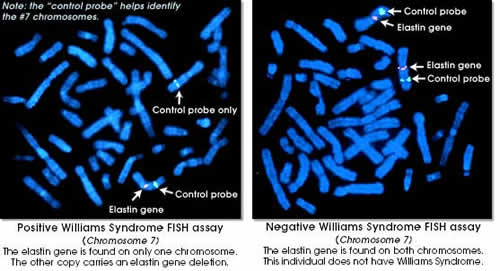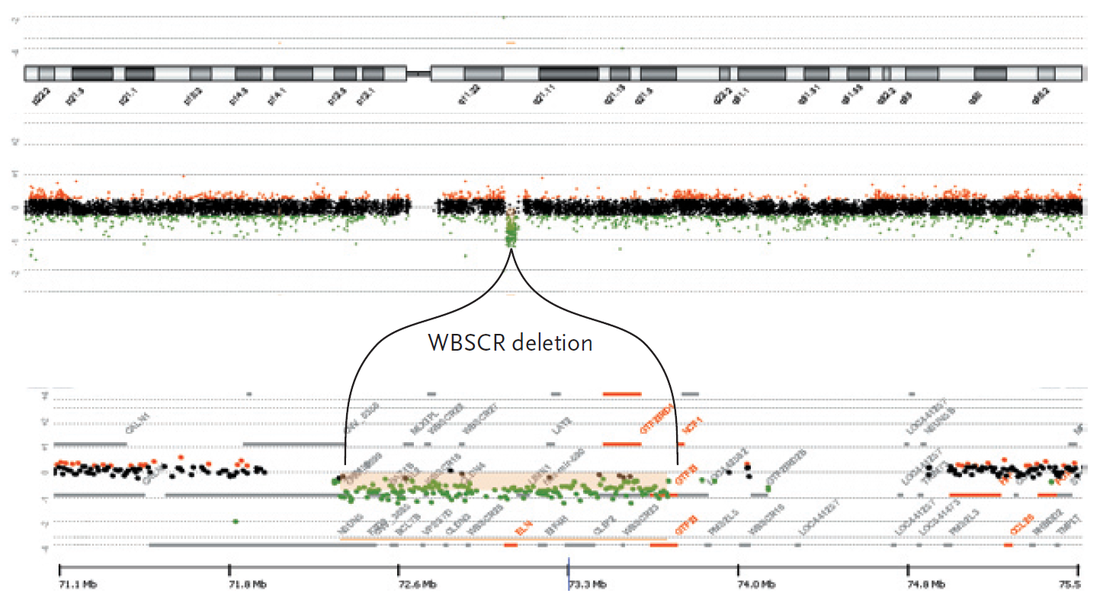
The diagnosis of Williams syndrome generally has two parts:
- Clinical diagnosis based on a variety of characteristics. See What is Williams syndrome for details.
- Medical/genetic test confirmation through a DNA test performed on a small amount of blood from the individual.
Virtually all (98-99%) persons with typical features of Williams syndrome will have a deletion of the elastin gene.
In more technical terms: Williams syndrome is the result of a deletion of the 7q11.23 region of chromosome #7 containing 26-28 genes, including the elastin gene. Elastin is the "marker gene" for Williams syndrome.
Williams syndrome is a contiguous gene syndrome, which means that all of the deleted genes "line up" within the Williams syndrome "critical region" of 26-28 genes. There are two DNA tests that can determine if a person has Williams syndrome. The FISH test and the Microarray.
It is important to stress that WS is a genetic diagnosis and an individual who does not have the gene deletion does not have Williams syndrome (i.e. a person who was clinically diagnosed with WS based on characteristics of the syndrome but was later found not have a deletion in fact does NOT have Williams syndrome.
NOTE: It is extremely unlikely that any other family member will also have Williams syndrome. That is because the deletion occurs spontaneously at a rate of just 1 in 7,500. However, if the individual with Williams syndrome plans to become a parent, there is a 50/50 chance that his or her child will have Williams syndrome. If such a situation should arise, consult an obstetrician about using the FISH test for prenatal testing of the embryonic cells.
THE FISH TEST
 A laboratory can use the technique known as fluorescent in situ hybridization (FISH) to confirm the diagnosis of Williams syndrome. FISH is a type of specialized chromosome analysis utilizing specially prepared elastin probes. If a patient has 2 copies of the elastin gene (one on each of their chromosomes #7), they probably do not have WS. If the individual only has one copy, the diagnosis of WS will be confirmed.
A laboratory can use the technique known as fluorescent in situ hybridization (FISH) to confirm the diagnosis of Williams syndrome. FISH is a type of specialized chromosome analysis utilizing specially prepared elastin probes. If a patient has 2 copies of the elastin gene (one on each of their chromosomes #7), they probably do not have WS. If the individual only has one copy, the diagnosis of WS will be confirmed.
The laboratory will need 5 ml of blood drawn in a Sodium heparin tube. The sample should arrive in the lab the same day it was drawn or on the following day. Results are usually available in 2-4 weeks.
The FISH test is readily available at major hospitals and cytogenetics laboratories around the country, but it is not a routine test. Therefore not all labs will do FISH-based diagnosis. Families or their physicians should call the lab in advance to make sure they can perform the test.
THE MICROARRAY
 A chromosomal microarray is a newer and preferred diagnostic tool that uses millions of markers to determine if there are missing pieces or extra pieces of DNA anywhere in the person’s chromosomes. This test is slower but gives more information about the missing piece of genetic material. The size of the deletion as well as the genes contained in the deletion are very important factors as they can offer clues to the severity of characteristics in an individual.
A chromosomal microarray is a newer and preferred diagnostic tool that uses millions of markers to determine if there are missing pieces or extra pieces of DNA anywhere in the person’s chromosomes. This test is slower but gives more information about the missing piece of genetic material. The size of the deletion as well as the genes contained in the deletion are very important factors as they can offer clues to the severity of characteristics in an individual.
